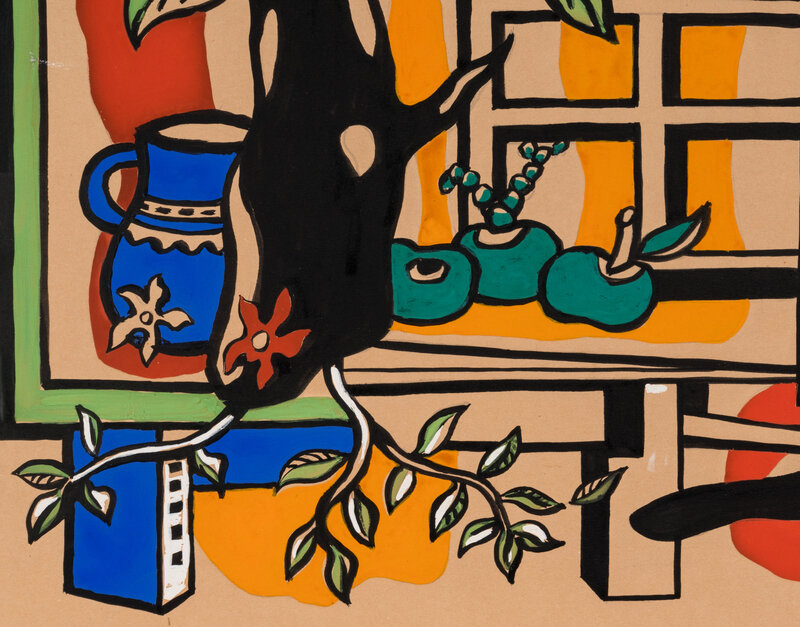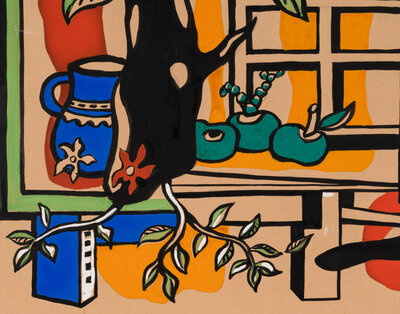Fernand Léger
(French, 1881–1955)
Nature Morte aux Pommes et Pichet devant la Fenêtre, 1952
Sale 2087 - Impressionist and Modern Art, Featuring the Collection of John and Rosetta Gernon
Oct 28, 2024
12:00PM ET
Live / Philadelphia
Own a similar item?
Estimate
$70,000 -
90,000
Price Realized
$82,550
Sold prices are inclusive of Buyer’s Premium
Lot Description
Fernand Léger
(French, 1881–1955)
Nature Morte aux Pommes et Pichet devant la Fenêtre, 1952
Gouache and ink on paper
Sheet size: 27 3/4 x 34 1/4 in. (70.5 x 87cm)
This lot is located in Chicago.
This work has been authenticated by the Comité Léger and will be sold with a Certificate of Authenticity.
Provenance:
Paul Breton, Paris.
Sotheby's, New York, sale of May 7, 2003, lot 334.
Acquired directly from the above sale by the present owner.
Literature:
Caroline Dubail, “Un Grand Palais pour Les Arts Ménagers (1926-1960),” in Les Dossiers Pédagogiques du Grand Palais, no. 7, 2020, p. 27 (illustrated).
Lot Essay:
In 1950, Fernand Léger declared the period that celebrated art for art’s sake and art without real objects was over. Instead, a new period was to begin, one in which artists returned to meaningful subjects that ordinary people could understand. He intended to appeal to the public with a more figurative style, one that rejected the elitist aesthetic of post-war abstraction. Léger maintained, however, that a return to the subject did not outright reject the use of abstract forms. It is precisely this fluctuation between the figurative and the abstract that lends the artist’s late work their energy.
As part of his dedication to a more inclusive approach to art, Léger embarked on an ambitious artistic program, working not just on multi-figural, brightly colored, monumental-sized paintings, but also on large murals, stained-glass windows, mosaics, sculptures, ceramics, and works on paper. One of these projects was the production in 1952 of three immense frescoes for the 21st Salon des Arts Ménagers (Household Arts Show), an annual exhibition in Paris of domestic appliances, furniture, and home designs. It was first held as the Salon des Appareils Ménagers (Home Appliances Fair) in 1923, with 100,000 visitors. By the 1950s, each exhibition attracted up to 1.4 million visitors. At the request of Paul Breton, the Commissaire Général du Salon des Arts Ménagers, Léger and his students executed Composition sur le Fond Marin (Composition on the seabed), Composition avec Poisson (Composition with fish), and Nature Morte aux Pommes et Pichet (Still life with apples and pitcher). The assemblage was painted on large pieces of fiber cement and assembled onsite. The choice of subjects relates to the placement of the works within a restaurant, which itself was located in the Salon des art ménagers.
Created in 1952, Nature Morte aux Pommes et Pichet devant la Fenêtre was likely a study or made as a souvenir of the project. At one point, it included a dedication to Breton from Léger, En Souvenir du Salon des Arts Ménagers 1952 / Cordialement. The objects within this composition – apples, a pitcher, and unusual sprouting plants – are depicted with areas of flattened, bold colors outlined with thick black lines. The still life objects are set against windows that appear to open into a limitless space and yet are bounded by amorphous planes of color. Creating the semblance of space within the composition, this mode of pictorial construction encapsulates the artist’s late style: as he stated, "black and white [are] two absolutes between which I go my way… Later…black gave the required intensity and by relying on it I was able to prise out the colour: for instead of circumscribing it by contours I was able to place it freely outside them’ (Léger, quoted in P. de Francia, Fernand Léger, New Haven & London, 1983, p. 254). These elements appear within a recognizable, yet spatially ambiguous plane, merging with the ground into a single, unified space.
The daring and radical use of color and flat planes with which the artist composed his late works is evocative of the still lifes of his contemporary, Henri Matisse. It was also to influence a new generation of post-war American artists, including Roy Lichtenstein, David Hockney, and Barnet Newman, who pushed the limits of color and form, ultimately freeing them completely from the picture plane. A brilliant colorist and a master of expansive spatial effects, Léger pioneered a new pictorial language that was emphatically abstract and powerfully emotive.
Condition Report
Auction Specialist





